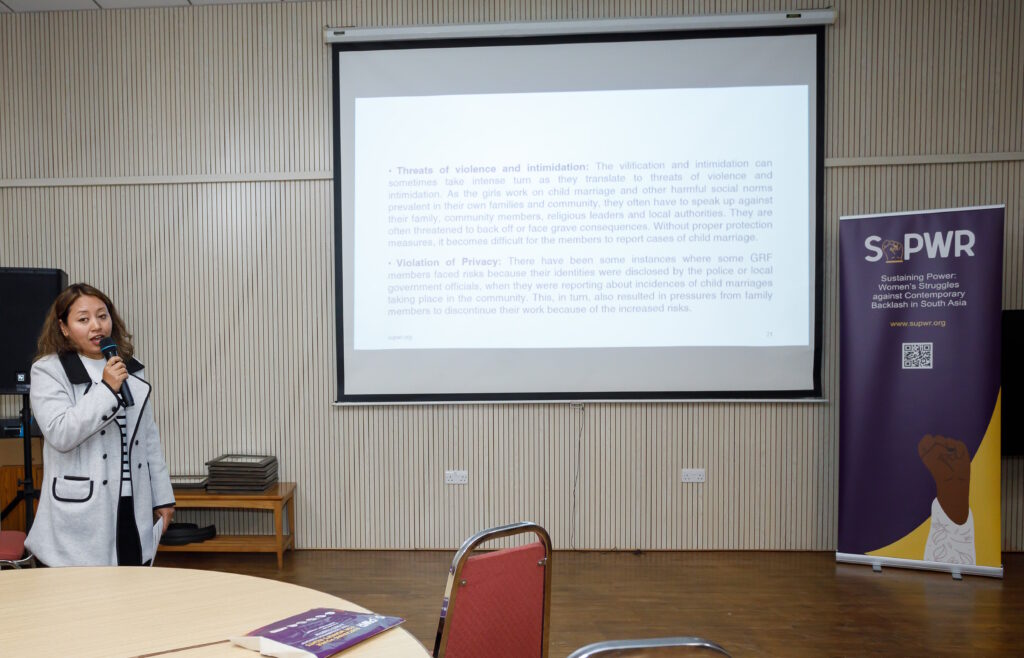“Dalit” originates from the Sanskrit word दलित (dalita), meaning “divided, split, broken, scattered”, it was originally used in the 1800s to describe the lower castes (untouchables) of the Hindu society. In Bangladesh, it is used to identify an outcast minority of oppressed, exploited, and deprived people based on both religious and socio-economic differences. About 3.5 million Dalits live in Bangladesh.
In Bangladesh, the Dalit community is not only a caste-based community but rather a population marginalised by both religious sanctions and economic deprivations. This puts the community in a position of double-discrimination, due to both their caste and religion and also due to their occupation and financial scarcity from another. Within the community, the adolescent girls are further marginalised by virtue of their age and gender, rendering them further voiceless.
As part of the Sustaining Power: Women’s Struggles against Contemporary Backlash in South Asia (SuPWR) project, BRAC Institute of Governance and Development (BIGD) is looking at the movement against child marriage. In collaboration Girls not Brides Coalition Bangladesh, along with Dalit – Hope for the Oppressed, an organisation working to empower the Dalit community in Southeast Bangladesh, data was collected from Dalit community members living in the Khulna City Corporation.
Causes of child marriage in the Dalit community
As part of the study, two focus group discussions (FGDs) were carried out, one with members of the community and another with the NGO staff. We discussed the causes of child marriage in the Dalit community as we wanted to understand the specificities of this community. The participants were asked to discuss the strategies Dalit took in the movement for stopping child marriage and the effectiveness of their strategies. It was interesting to see the similarities and differences in what they consider to be effective strategies, and the different criteria they think are important to even consider a strategy to be effective.
While discussing the causes of child marriage, a range of vulnerabilities came forward which is impacting the entire community. The children have high dropout rates, and their economic condition often forces them out of school. The nearest government school is also sometimes quite far. The lack of access to justice due to discrimination from nearby service providers also compounds the fear of their daughters’ physical safety. Under all these considerations, the parents marry off their daughters at a very young age.
This has led to the common saying “kuri te buri”, meaning that at 20 years of age you’re elderly, far too old to be married. Men’s families specifically look for a bride who does not yet have a NID (usually received at 18 years of age). Like adolescents across the country, there is a notable lack of sexual and reproductive health and rights (SRHR) knowledge and awareness of family planning services. Although the Dalit stipend incentivises parents and tries to send children, especially Dalit girls, to school. Dalit NGO also offers pre-schooling support for a mixed-age group in makeshift learning centres.
Backlash and strategies to end child marriage
Activists face different forms of backlash when working in the community to stop child marriage incidents. The most notable is the threat of expulsion from the community, and are immediately labelled a traitor to their own community if any external complaint is made. The participants mentioned a story where a school teacher tried to stop child marriage of a Dalit girl. As a result, the entire community turned against the teacher, who was eventually forced to leave the area. They also regularly face the threat of physical violence. Although public representatives personally believe this is a movement worth supporting, they are hesitant to coordinate with activists in any public setting. Rather they would prefer to keep their names entirely out of any such efforts out of fear of losing votes. If a girl herself stands up to her own marriage and manages to convince her parents, the entire family gets subjected to social stigma.
When it came to strategies, both parties felt that increasing the overall schooling of adolescents, along with specific conversations with them and their families about the risks of child marriage, are extremely successful strategies. Both the NGO and community members emphasised on completion of HSC as a sign of success when it comes to stopping child marriage, along with an increase in the girls’ ability to express opinions and actively participate in household decision-making. They also referred to the financial independence of the girls or income generation as relevant criteria.
The community preferred the courtyard meeting approach with families present, while NGOs mentioned their SRHR training sessions with the adolescents as another strategy to stop child marriage. The community mentioned involving neighbours and ward councillors to stop child marriage to be quite an effective strategy too.
On the other hand, calling 999 was said to be extremely ineffective. NGOs also put legal discussions of the CMRA (Child Marriage Restraint Act) 2017 as the least effective strategy. While the NGOs spoke of proper implementation of laws around child marriage, this conversation was mostly missing during the community FGD. Rather, they focused on issues within the community such as a decrease in maternal and neonatal mortality and a decrease in domestic violence and divorce rate.
Minority communities have their own intersection of vulnerabilities, which must be addressed in highly specific and contextualised ways. By reviewing the differences in NGO and community approaches, we see that there is scope to further modify combat efforts to make them more acceptable and comfortable to the intended beneficiaries.
Anjali’s story
In collaboration with ‘Dalit – Hope for the Oppressed’, BIGD produced a documentary film under the SuPWR project, which features Anjali, a Dalit girl in her early 20s, who stopped her own child marriage and continued her education. Watch the documentary below.
—
